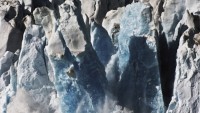China’s Asteroid Flyby May Unlock Secrets of the Solar System
| Michael A. Katz | | Nov 19, 2015 04:33 PM EST |
(Photo : getty Images) Researchers have published a paper detailing the observations of a Chinese lunar probe's flyby of a major asteroid, which they say could “provide the key to the formation of planets, the evolution of Solar system and the origin of life on the Earth.”
Chinese researchers have published a paper detailing the observations of its lunar probe's flyby of a major asteroid, which they say "may provide key clues on the formation of the Solar system."
In December of 2012, Chang'e-2 - the same probe China used to investigate the moon in 2010 - completed a successful flyby of the near-Earth asteroid 4179 Toutatis. At its closest, the probe was 770 meters from the asteroid's surface, or less than half a mile, says the team of of researchers from the Chinese Academy of Sciences.
Like Us on Facebook
It was the first time that images of Toutatis were acquired at such a close range, and a total of about 425 images were taken. After its close encounter with the asteroid, the probe is still alive and flying far into space, more than 100 million kilometers in a heliocentric orbit of Earth.
The asteroid was first discovered in 1934, then was observed again 55 years later in 1989. Observations show that Toutatis has an irregular shape with two distinct lobes. And because it originates from the main asteroid belt, it could "provide the key to the formation of planets, the evolution of Solar system and the origin of life on the Earth."
The Chang'e-2 flyby " provides us new observations to understand the formation scenario of asteroids," said the researchers in their paper. "As the previous investigations shown, Toutatis is an S-type asteroid that probably has a rubble-pile structure."
They also found that Toutatis may be not a monolithic structure, but a coalescence of shattered rocks. However, they added that "the formation of Toutatis is not fully understood yet."
From flyby images, Toutatis was observed covered by abundant concavities, indicating that impact cratering may play an significant role in forming the present surface. However, the scientists acknowledged that the overall quality of the optical images is "relatively poor" because they were captured by the monitoring camera. In addition, they said the high solar phase angle is not conducive to accurate topographic analyses.
Chang'e 2 was launched in October of 2010, the successor to the Chang'e 1 lunar probe, which was launched in 2007. Chang'e 2 was part of the first phase of China's Lunar Exploration Program, and conducted research from a 100-km lunar orbit in preparation for the landing by the Chang'e 3 rover. The probe was aptly named after an ancient Chinese moon goddess.
TagsChina’s Flyby of Asteroid May Unlock Secrets of Solar System Formation, China’s Asteroid Flyby May Unlock Secrets of the Solar System, China’s Asteroid Flyby Could Unlock Secrets of the Solar System, lunar probe Chang’e-2, near-Earth asteroid 4179 Toutatis, The Chinese Academy of Sciences, rubble-pile structure, chinese space program, asteroids
©2015 Chinatopix All rights reserved. Do not reproduce without permission
EDITOR'S PICKS
-

Did the Trump administration just announce plans for a trade war with ‘hostile’ China and Russia?
-

US Senate passes Taiwan travel bill slammed by China
-

As Yan Sihong’s family grieves, here are other Chinese students who went missing abroad. Some have never been found
-

Beijing blasts Western critics who ‘smear China’ with the term sharp power
-

China Envoy Seeks to Defuse Tensions With U.S. as a Trade War Brews
-

Singapore's Deputy PM Provides Bitcoin Vote of Confidence Amid China's Blanket Bans
-

China warns investors over risks in overseas virtual currency trading
-

Chinese government most trustworthy: survey
-

Kashima Antlers On Course For Back-To-Back Titles
MOST POPULAR
LATEST NEWS
Zhou Yongkang: China's Former Security Chief Sentenced to Life in Prison

China's former Chief of the Ministry of Public Security, Zhou Yongkang, has been given a life sentence after he was found guilty of abusing his office, bribery and deliberately ... Full Article
TRENDING STORY

China Pork Prices Expected to Stabilize As The Supplies Recover

Elephone P9000 Smartphone is now on Sale on Amazon India

There's a Big Chance Cliffhangers Won't Still Be Resolved When Grey's Anatomy Season 13 Returns

Supreme Court Ruled on Samsung vs Apple Dispute for Patent Infringement

Microsoft Surface Pro 5 Rumors and Release Date: What is the Latest?














